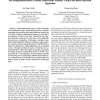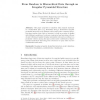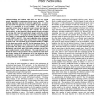121
click to vote
IPL
2002
15 years 20 days ago
2002
Splay trees are self-organizing binary search trees that were introduced by Sleator and Tarjan [12]. In this paper we present a randomized variant of these trees. The new algorith...
ASPDAC
2008
ACM
15 years 3 months ago
2008
ACM
Content addressable memory (CAM) is frequently used in applications, such as lookup tables, databases, associative computing, and networking, that require high-speed searches due t...
GBRPR
2009
Springer
15 years 5 months ago
2009
Springer
This paper proposes to transform data scanned randomly in a well-defined space (e.g, Euclidean) along a hierarchical irregular pyramidal structure in an attempt reduce search time...
GLOBECOM
2006
IEEE
15 years 7 months ago
2006
IEEE
Flooding and random walk (RW) are the two typical search algorithms in unstructured peer-to-peer networks. The flooding algorithm searches the network aggressively. It covers the m...
BIBE
2007
IEEE
15 years 7 months ago
2007
IEEE
—The performance of maximum likelihood searches can be boosted by using the most parsimonious tree as a starting point for the search. The time spent in performing the parsimony ...



